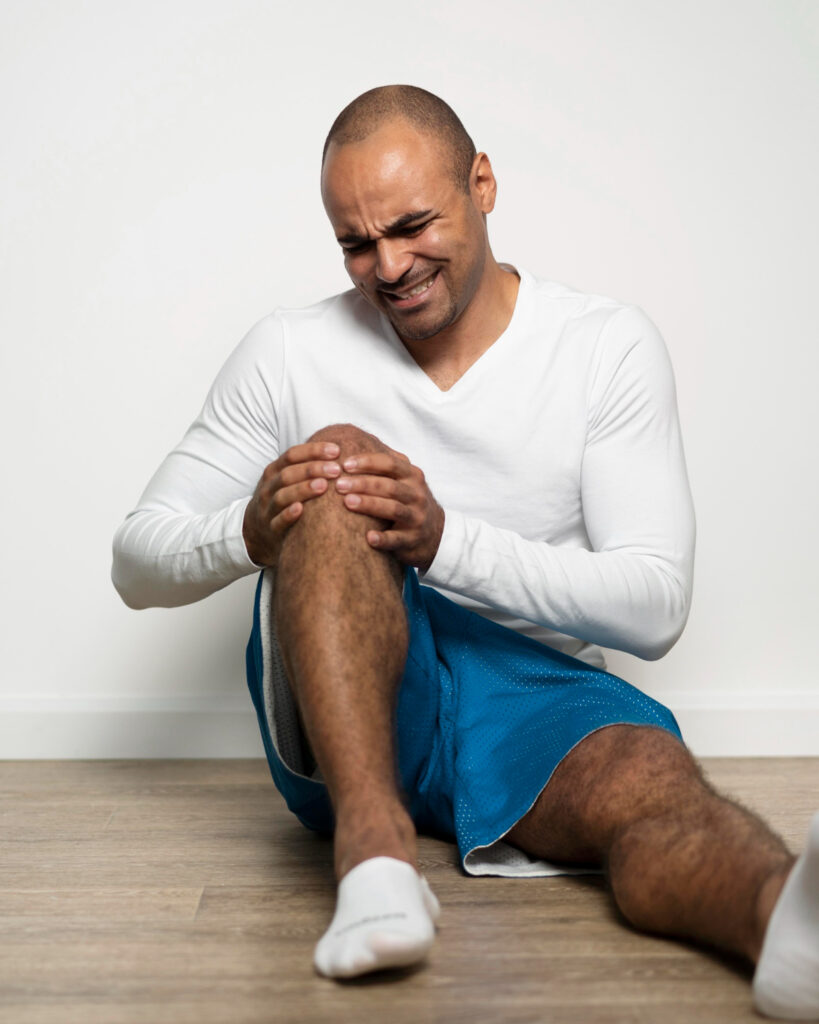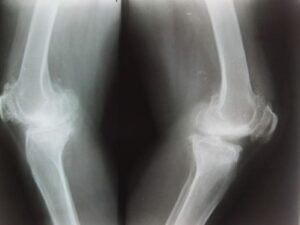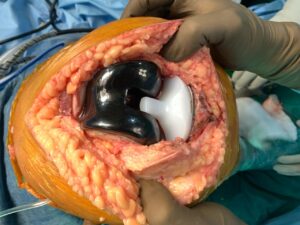Top 7 Most Common Knee Pain Causes & their ultimate treatment one must know!

Knee Pain
What is knee pain?
It’s pretty normal to have achy knees, and usually, it’s not a big deal. There are lots of things that could cause it, like a little muscle pull or inflammation in the tendons, or even certain types of arthritis. Sometimes, though, it’s hard to figure out why your knees hurt.
As you get older, having knee pain might happen more often. And if you’re carrying extra weight, you’re more likely to have knee trouble. Sometimes, knee pain happens because of a sports injury or some other kind of accident.
Common Knee Pain Causes
- Knee Injury

There are lots of ways you can hurt your knee. You might strain it, sprain it, tear a ligament (like your ACL), tear some cartilage, or even break a bone. These injuries can happen if you land funny on your foot, take a tumble, twist your knee, or get a hard knock on it. The swelling around the injury is what usually makes it hurt.
2. Overusing Your Knee
When you’re active, like playing sports or doing physical work, it can put stress on your knee. Doing the same movement over and over again, like jumping a lot or spending a long time on your hands and knees, can make your knee hurt.
Knee pain can happen if you’re overusing your knee. Some common problems from overuse include:
- Patellofemoral pain (also called runner’s knee)-
- Osgood-Schlatter disease (only in kids and teens, also called jumper’s knee).
- Tendinitis (especially patellar tendinitis)
3. Arthritis
Arthritis makes your joints hurt and swell up. Lots of people get arthritis in their knees. It makes your knees hurt, swell, and feel stiff. There are different kinds of arthritis that can make your knees ache, like:
- Osteoarthritis.
- Rheumatoid arthritis.
- Post-traumatic arthritis
4. Mechanical Issues
Here are some examples of mechanical problems that can make your knee hurt:
- Loose body: Sometimes, if you hurt your knee or if the bone and cartilage start to wear out, a piece of bone or cartilage can break off and float around in your knee joint. It might not bother you unless it gets in the way of your knee moving, kind of like a pencil stuck in a door hinge.
- Iliotibial band syndrome: This happens when a tough band of tissue from your hip to your knee gets too tight and rubs against the side of your thighbone. People who run long distances or bike a lot are more likely to have this problem.
- Dislocated kneecap: This is when the triangle-shaped bone that covers the front of your knee slips out of place, usually to the side. Sometimes, it stays out of place and you can see that it’s dislocated.
- Hip or foot pain: If your hip or foot hurts, you might walk differently to avoid putting pressure on the painful joint. But walking differently can put more stress on your knee and make it hurt.
5. Knee Pain As one ages
As people get older, their knees can have more problems. Their joints might not work as well and could get hurt more easily. Sometimes, they might feel pain in their knees even if they never did before. It’s important to see a doctor who knows about bones and muscles if this happens. They can find out why the knees hurt and suggest ways to make them feel better. One common reason for knee pain in older people is called osteoarthritis.
6. Over weight
Carrying too much weight is tough on your knees. Some time ago, scientists discovered that for every extra pound you weigh, it’s like putting four more pounds of pressure on your knees.
Even though knees are strong, they have their limits. If they’re stressed out for too long, they can start having problems like really bad pain and trouble moving.
7. Hamstring Strain
A hamstring strain happens when the muscle at the back of your thigh gets hurt.
It’s like when you pull a muscle, usually because you stretch it too much or move it suddenly.
When this happens, some of the muscle fibers can tear, and it can hurt when you walk or climb stairs.
Depending on how bad it is, you might have symptoms like:
- Pain
- Tenderness when you touch the hamstring
- Swelling
- Bruising
Another kind of muscle injury that can cause knee pain is a quadriceps strain, which is when the muscle at the front of your thigh gets stretched too much.
Diagnosis of Knee Pain
- Blood Tests: Blood tests can look for an anti-CCP antibody, which might show if someone has rheumatoid arthritis. There are also other antibodies that could mean someone has a bigger problem like lupus, where the body’s inflammation happens all over.
- Knee Fluid Test: Doctors can take fluid out of the knee to check it. If the fluid has crystals made of uric acid, it could mean gout is causing the swelling and pain. If there are bacteria in the fluid, it shows that an infection is causing these problems.
- X-rays: X-rays can show if there are signs of arthritis by looking at the space between the bones, checking for bone spurs, or seeing if the joint isn’t lined up right.
- CT scans and MRI scans make even clearer pictures of bones and soft tissues. Doctors use them more to find out what’s wrong when there’s an injury or swelling without a clear reason. For example, if your doctor thinks you might have torn cartilage or a ligament, they’ll probably ask for an MRI scan.
Home Remedies to Prevent Knee Pain
Here are some things you can do at home to help with knee pain:
- Lose Weight: Shedding some pounds can reduce the pressure on your knees. It’s recommended to aim for a 5 percent weight loss over 20 weeks according to Osteoarthritis Research Society International (OARSI) guidelines.
- Stay Active: Doing exercises that strengthen and stretch your knees can make a big difference. This can improve how well your knees work and ease pain and stiffness. You can try exercises like yoga on land or aquatic aerobics in water to help with this.
- Cold and Hot Fomentation for Knee Pain For Acute Pain:
- Cold Fomentation For Acute Pain: Apply cold pack for 15-20 minutes every hour on the first day, then every 3-4 hours. Always wrap the ice in a towel or cloth.
- Hot FomentationFor Chronic Pain: Use a warm compress or heating pad as needed.
- Compression: Wrap something snug around your knee to help reduce swelling. An Orthopedic Doctor can teach you how to do this safely.
- Elevation: Keep your knee up higher than your heart. You can do this by putting pillows or cushions under your knee.
Surgical Treatment For Knee Pain
If one has knee pain, Orthopedic Doctor, Dr. Preetesh Choudhary at MLs Clinic Indore, will suggest following surgical Knee pain treatment options
- Corticosteroids are a type of medicine that can really help with knee arthritis. One of the best ones is triamcinolone acetonide, also known as Zilretta. It’s the only medicine approved by the FDA to treat knee osteoarthritis. It works by being injected into your knee and then releasing medicine slowly over three months. This slow release can ease pain and swelling and also lessen some of the bad effects of steroids, like raising your blood sugar levels.
- Topical pain relievers
- Hyaluronic acid injections are sometimes used for knee arthritis to add fluid to the joint and reduce pain. However, more research is needed to understand how well it works.
- Knee Braces: A knee brace helps your knee by supporting it and keeping it steady. It’s like a sturdy frame made of hard plastic or metal with soft pads and straps. These straps wrap around your knee and leg to keep everything in the right position. Your doctor will let you know what kind of brace you need and how long you should wear it.
- Surgery: Surgery for knee pain is not usually the first option. But if your pain is really bad and
 nothing else is working, your doctor might suggest it. Knee Surgery could be necessary if you have a torn ligament, a broken bone, or if your arthritis is very severe.
nothing else is working, your doctor might suggest it. Knee Surgery could be necessary if you have a torn ligament, a broken bone, or if your arthritis is very severe.

 nothing else is working, your doctor might suggest it. Knee Surgery could be necessary if you have a torn ligament, a broken bone, or if your arthritis is very severe.
nothing else is working, your doctor might suggest it. Knee Surgery could be necessary if you have a torn ligament, a broken bone, or if your arthritis is very severe.






Massa suspendisse lorem turpis ac. Pellentesque volutpat faucibus pellentesque velit in, leo odio molestie, magnis vitae condimentum.
Aute mi ut suspendisse velit leo, vel risus ac. Amet dui dignissim fermentum malesuada auctor volutpat, vestibulum ipsum nulla.
Sed reprehenderit quam, non felis, erat cum a, gravida lorem a. Ultricies in pellentesque ipsum arcu ipsum ridiculus velit magna, ut a elit est. Ultricies metus arcu sed massa. Massa suspendisse lorem turpis ac.
Eu et tellus vestibulum taciti et sit, nunc enim ipsum donec aliquam vitae, per mauris, amet ultrices. Pellentesque amet proin ut vestibulum eleifend nam, wisi vel tellus pulvinar mi risus consectetuer, sed faucibus facilisi, accumsan nam.
Comments are closed.